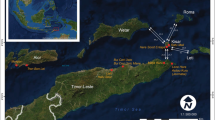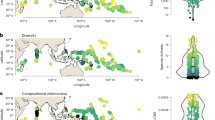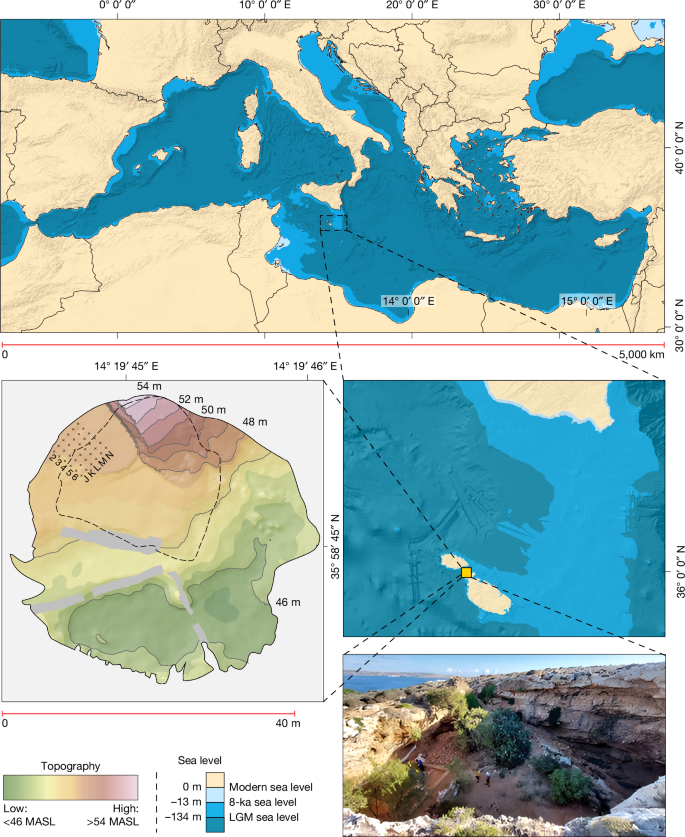Hunter-gatherer sea voyages extended to remotest Mediterranean islands
地中海最偏远岛屿的早期人类:采集狩猎者航海范围拓展研究
Your privacy, your choice
我们使用必要的 cookies 来确保网站正常运行。我们也使用可选的 cookies 进行广告宣传、内容个性化、使用情况分析和社交媒体。
通过接受可选 cookies,您同意处理您的个人数据,包括传输给第三方。某些第三方位于欧洲经济区之外,数据保护标准各不相同。
有关使用您的个人数据的更多信息,请参阅我们的 privacy policy。
管理首选项以获取更多信息并更改您的选择。
Accept all cookies
Skip to main content
感谢您访问 nature.com。您使用的浏览器版本对 CSS 的支持有限。 为了获得最佳体验,我们建议您使用更新的浏览器(或关闭 Internet Explorer 中的兼容模式)。 同时,为了确保持续支持,我们在不使用样式和 JavaScript 的情况下显示网站。
Advertisement

Search
按主题、关键词或作者搜索文章 Show results from All journals This journal Search Advanced search
Quick links
* [Explore articles by subject](https://www.nature.com/articles/</subjects>)
* [Find a job](https://www.nature.com/articles/</naturecareers>)
* [Guide to authors](https://www.nature.com/articles/</authors/index.html>)
* [Editorial policies](https://www.nature.com/articles/</authors/editorial_policies/>)
Explore content
* [ Research articles ](https://www.nature.com/articles/</nature/research-articles>)
* [ News ](https://www.nature.com/articles/</news>)
* [ Opinion ](https://www.nature.com/articles/</opinion>)
* [ Research Analysis ](https://www.nature.com/articles/</research-analysis>)
* [ Careers ](https://www.nature.com/articles/</careers>)
* [ Books & Culture ](https://www.nature.com/articles/</books-culture>)
* [ Podcasts ](https://www.nature.com/articles/</nature/podcasts>)
* [ Videos ](https://www.nature.com/articles/</nature/videos>)
* [ Current issue ](https://www.nature.com/articles/</nature/current-issue>)
* [ Browse issues ](https://www.nature.com/articles/</nature/browse-issues>)
* [ Collections ](https://www.nature.com/articles/</nature/collections>)
* [ Subjects ](https://www.nature.com/articles/</nature/browse-subjects>)
* [Follow us on Facebook ](https://www.nature.com/articles/<https:/www.facebook.com/Nature>)
* [Follow us on Twitter ](https://www.nature.com/articles/<https:/twitter.com/nature>)
* [Sign up for alerts ](https://www.nature.com/articles/<https:/www.nature.com/my-account/alerts/subscribe-journal?list-id=1>)
* [ RSS feed ](https://www.nature.com/articles/<https:/www.nature.com/nature.rss>)
About the journal
* [ Journal Staff ](https://www.nature.com/articles/</nature/journal-staff>)
* [ About the Editors ](https://www.nature.com/articles/</nature/editors>)
* [ Journal Information ](https://www.nature.com/articles/</nature/journal-information>)
* [ Our publishing models ](https://www.nature.com/articles/</nature/our-publishing-models>)
* [ Editorial Values Statement ](https://www.nature.com/articles/</nature/editorial-values-statement>)
* [ Journal Metrics ](https://www.nature.com/articles/</nature/journal-impact>)
* [ Awards ](https://www.nature.com/articles/</nature/awards>)
* [ Contact ](https://www.nature.com/articles/</nature/contact>)
* [ Editorial policies ](https://www.nature.com/articles/</nature/editorial-policies>)
* [ History of Nature ](https://www.nature.com/articles/</nature/history-of-nature>)
* [ Send a news tip ](https://www.nature.com/articles/</nature/send-a-news-tip>)
Publish with us
* [ For Authors ](https://www.nature.com/articles/</nature/for-authors>)
* [ For Referees ](https://www.nature.com/articles/</nature/for-referees>)
* [ Language editing services ](https://www.nature.com/articles/<https:/authorservices.springernature.com/go/sn/?utm_source=For+Authors&utm_medium=Website_Nature&utm_campaign=Platform+Experimentation+2022&utm_id=PE2022>)
* [Submit manuscript ](https://www.nature.com/articles/<https:/mts-nature.nature.com/>)
Hunter-gatherer sea voyages extended to remotest Mediterranean islands Download PDF Download PDF
- Article
- Open access
- Published: 09 April 2025
采集狩猎者的航海活动扩展到最偏远的 Mediterranean 岛屿
- Eleanor M. L. Scerri ORCID: orcid.org/0000-0002-7468-99771,2,3,
- James Blinkhorn ORCID: orcid.org/0000-0002-9399-55151,4,
- Huw S. Groucutt ORCID: orcid.org/0000-0002-9111-17202,3,
- Mathew Stewart5,
- Ian Candy6,
- Ethel Allué7,8,
- Aitor Burguet-Coca ORCID: orcid.org/0000-0002-1866-816X7,8,9,
- Andrés Currás ORCID: orcid.org/0000-0002-1828-74551,
- W. Christopher Carleton ORCID: orcid.org/0000-0001-7463-863810,
- Susanne Lindauer ORCID: orcid.org/0000-0001-5363-275511,
- Robert Spengler12,
- Kseniia Boxleitner12,
- Gillian Asciak13,
- Margherita Colucci ORCID: orcid.org/0000-0002-0934-194X1,14,
- Ritienne Gauci15,
- Amy Hatton10,16,17,
- Johanna Kutowsky1,
- Andreas Maier ORCID: orcid.org/0000-0002-5021-33413,
- Mario Mata-González ORCID: orcid.org/0000-0002-7130-14631,2,
- Nicolette Mifsud2,
- Khady Niang1,18,
- Patrick Roberts ORCID: orcid.org/0000-0002-4403-754810,19,
- Joshua de Giorgio20,
- Rochelle Xerri21 &
- …
- Nicholas C. Vella ORCID: orcid.org/0000-0001-7680-920X2
Show authors Nature (2025)Cite this article
- 22k Accesses
- 691 Altmetric
- Metrics details
摘要
马耳他群岛是一个小型岛链,是 Mediterranean 地区最偏远的岛屿之一。人们认为,直到大约 7500 年前 (ka) 区域转向新石器时代的生活方式时1,人类才到达并居住在这些小而孤立的岛屿上。 在传统观点中,小岛屿有限的资源和生态脆弱性,加上远距离航海的技术挑战,意味着采集狩猎者要么无法,要么不愿意进行这些航行2,3,4。 在这里,我们描述了年代学、考古学、动物学和植物学数据,这些数据支持 Holocene 采集狩猎者在马耳他群岛的存在。 在这个时候,马耳他的地理构造和海平面与今天的大致相同,需要从最近的陆地西西里岛航行大约 100 公里。 居住始于大约 8.5 ka,可能持续到大约 7.5 ka。 这些采集狩猎者利用陆地动物,但也能够利用海洋资源和鸟类,帮助这些群体在一个小岛屿上维持生存。 我们的发现记录了 Mediterranean 地区迄今为止已知的最长的采集狩猎者海上航行,提高了整个区域内未知的、早期的连接的可能性。
Similar content being viewed by others

Earliest known funerary rites in Wallacea after the last glacial maximum
Article Open access 02 January 2024

Early Sri Lankan coastal site tracks technological change and estuarine resource exploitation over the last ca. 25,000 years
Article Open access 04 November 2024

Atolls are globally important sites for tropical seabirds
Article 15 August 2024
Main
远距离航海的出现在全球范围内差异很大,东南亚和 Sahul 地区的早期出现似乎直到后来才在非洲海岸附近的岛屿等其他地区复制5,6,7,8,9。 马耳他群岛距离西西里岛约 100 公里,距离 Maghreb 约三倍之远,是 Mediterranean 地区最偏远的岛屿群之一,Mediterranean 是世界上最大的内陆海(图 1)。 大约 13 ka 前,海平面上升迅速淹没了从马耳他到西西里岛的低洼、现在大约 95 米深的假想陆桥。 在接下来的几千年里,西西里岛和马耳他群岛都达到了目前的构造,马耳他现在的总陆地面积仅为 316 平方公里(参考文献 10)。 像其他小的 Mediterranean 岛屿一样,特别是考虑到其半干旱气候,马耳他被推断为太小和太偏远,无法在新农业和更先进的航海技术采用之前支持人类居住(参见补充信息 1 进行讨论)。 普遍的共识是,采集狩猎者只会前往大的和/或容易到达的 Mediterranean 岛屿,例如通过连接岛屿链、靠近大陆或有利的洋流1,2,11(补充信息 1)。
Fig. 1: Maps and image of Latnija.
 Top, the position of Malta in the Mediterranean. Bottom left, digital elevation model of Latnija, showing the current dripline in dashed lines. Bottom right, the site, showing the sea channel and Gozo in the background, with past sea levels based on a previous study49. LGM, Last Glacial Maximum; MASL, metres above sea level. The edge of Trench 4 is denoted by the hessian sacks. Data from refs. [50](https://www.nature.com/articles/</articles/s41586-025-08780-y#ref-CR50> "Japan Aerospace Exploration Agency. ALOS world 3D—30m, version 3.2 OpenTopography
https://doi.org/10.5069/G94M92HB
Top, the position of Malta in the Mediterranean. Bottom left, digital elevation model of Latnija, showing the current dripline in dashed lines. Bottom right, the site, showing the sea channel and Gozo in the background, with past sea levels based on a previous study49. LGM, Last Glacial Maximum; MASL, metres above sea level. The edge of Trench 4 is denoted by the hessian sacks. Data from refs. [50](https://www.nature.com/articles/</articles/s41586-025-08780-y#ref-CR50> "Japan Aerospace Exploration Agency. ALOS world 3D—30m, version 3.2 OpenTopography
https://doi.org/10.5069/G94M92HB
\(2021\)."),[51](https://www.nature.com/articles/</articles/s41586-025-08780-y#ref-CR51> "GEBCO Bathymetric Compilation Group 2019. The GEBCO_2019 Grid—a continuous terrain model of the global oceans and land. British Oceanographic Data Centre
https://doi.org/10.5285/836f016a-33be-6ddc-e053-6c86abc0788e
\(2019\).") and created using ArcMap 10.5.
Full size image 以前的研究支持了这一观点,证据表明,到达马耳他的第一批人是新石器时代的农民,他们与源自西西里岛新石器时代“Stentinello”阶段的压印陶器有关12,13,14。 这些农民被认为将农作物以及驯养和共生动物引入了原始岛屿生态系统14。 马耳他新石器时代开始的直接年代测定和确凿证据表明年龄约为 7.4 ka(参考文献 15),这与新石器时代从意大利南部传播的区域年表一致16。 它也与我们自己的年代学模型一致(Methods、补充信息 1 和扩展数据图 1) 基于具有良好背景信息的放射性碳年代的大型数据库,表明意大利南部和西西里岛最早的新石器时代可以追溯到大约 7.9–7.5 ka,而马耳他则稍晚,大约在 7.4–7.1 ka。 虽然偶尔有人声称西西里岛和马耳他的新石器时代更早,但由于放射性碳年代测定和年龄模型具有高度不确定性,加上与上述区域年表不一致,因此存在问题(补充信息 1 和扩展数据图 2 和 3)。 尽管也有人声称马耳他远古更新世时期就有人类存在17,[18](https://www.nature.com/articles/</articles/s41586-025-08780-y#ref-CR18> "Mifsud,